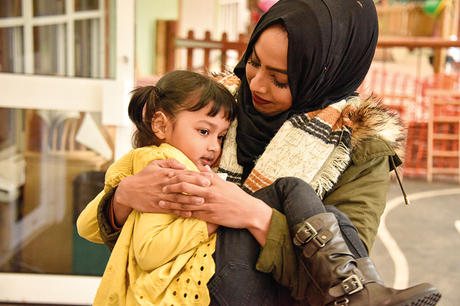
How often do you hear early years practitioners complaining about the chores connected with assessment and paperwork? I hear this a lot when I am working with schools and settings. I also see practitioners endlessly scribbling on Post-Its or holding up iPads to snap photos of children so that they can collect evidence of their learning, when it looks to me like those children would do better if they had someone to listen to them and play with them.
This bothers me greatly, because it makes me feel like we must have taken a wrong turn in the early years. In this age of measurement and ranking, we are in danger of placing so much emphasis on our Learning Journeys, online journals and collections of assessment information that we end up neglecting what matters: children’s minute-by-minute experiences in the early years, and our opportunities to support their learning, offer them the best possible care, and teach them new skills.
In settings and schools, there are endless checklists derived from Development Matters, creating hundreds of tick boxes. There is already plenty to think about, with 17 aspects of the EYFS broken down into six age-bands, together with three Characteristics of Effective Learning broken down into nine strands. Yet it is common to break down each age-band into many individual statements to tick off, or to divide each band into three levels, such as ‘emerging’, ‘working’ and ‘secure’. That generates a huge number of assessments to complete.
Yet Development Matters was never designed to be used like this. Nor is there anything in Ofsted’s Common Inspection Framework which tells us to do this. The amount of assessment work we are doing is a kind of madness. As we do more and more, faster and faster, are we getting anywhere? It reminds me of the exchange between Alice and the Red Queen, in Lewis Carroll’s Through the Looking Glass:
‘Well, in our country,’ said Alice, still panting a little, ‘you’d generally get to somewhere else – if you run very fast for a long time, as we’ve been doing.’
‘A slow sort of country!’ said the Queen. ‘Now, here, you see, it takes all the running you can do, to keep in the same place. If you want to get somewhere else, you must run at least twice as fast as that!’
To counteract the madness, 12 maintained nursery schools worked together to rethink early years assessment, putting an emphasis on quality, accuracy and usefulness. Our work will be available online by the end of January. But before we look at this project, I would like to take a quick look at some of the pioneering early years practice which helped to shape our thinking.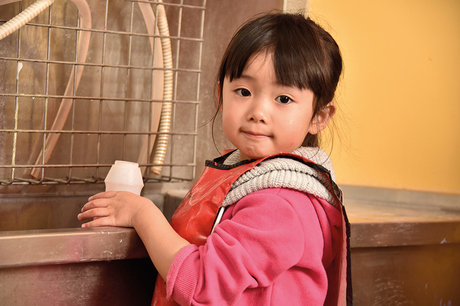
BACK TO THE FUTURE?
Some of the best examples of observations about children’s play and learning come from the work of Susan Isaacs, who led the experimental Malting House School between 1924 and 1929. Isaacs had a great gift of capturing children’s activity clearly and vividly. If we want to get a ‘feel’ for the child’s learning, and celebrate it in a way which is lively and engaging and will speak to parents, her work offers much inspiration. Here is her account of Tommy in 1926, published in her classic book Social Development in Young Children:
Tommy gathered figs from the fig tree, cut them into halves, and made presents of them to the other children. The older ones were very much occupied, and Noel said he didn’t want the figs – with some impatience at being interrupted. Tommy asked, with a puzzled air, ‘Why doesn’t he want them?’ He asked where Priscilla was, as he wanted to give her a present. She had gone home early, and he said he would send them to her. Mrs I. asked, ‘How will you send them?’ ‘Well, if you’ll give me an envelope, I’ll put them in it.’ She gave him one, and he asked her to write the address on it, he dictating. He then said, ‘I’ll post it if you’ll give me a stamp’, and he did so, putting in the two halves of a fig.
Reading this brief paragraph, we learn a huge amount about Tommy: his early exploration of numbers and fractions, how he notices and is puzzled that other children do not feel the same as he does; his kindness towards his friend Priscilla and his understanding of writing, addresses and the postal system. Tommy comes to life in this observation: I could imagine sharing it with a parent and talking about all the aspects of his development listed above, and more.
But merely looking back is an inadequate way to find a path to the future. Isaacs has much to offer, yet the limitations of her work are also clear to us now. As the educational researcher and writer Mary Jane Drummond pointed out in Learning without limits (2004), Isaacs had a fixed view of children’s mindsets, assuming that ability was mostly inherited. Isaacs wrote in 1932 that ‘of all the differences between one child and another, inborn intelligence turns out to be the most stable and the most permanent… The best teaching in the world may prove barren if it falls on the stony ground of an inherently dull and lifeless mind.’
Arguably, from the work of Isaacs and others, there comes a rather poorly thought-out view that children’s learning is simply an unfolding of their innate capability in a supportive environment, just like a butterfly will emerge from a cocoon if the conditions are favourable. In my experience, this is still quite widely believed among early years practitioners. But there is now considerable evidence from many decades of research that children’s learning depends both on their inner resources, and the ‘scaffolding’ which adults offer.
An equally unhelpful way of thinking, in complete opposition to this, is the view that young children need simple programmes of instruction. The American researcher Lilian Katz warns us not to model our early education and care ‘on the corporate/industrial or factory model so pervasive in the primary and secondary levels of education… Factories are designed to transform raw material into prespecified products by treating it to prespecified standard processes.’
In brief, we can learn a great deal from Isaacs’ focus on capturing what is unique about each child as they play, talk and learn. Early education should not be like a factory to standardise each child. But nor is it about just standing back and letting the innate talents of one child blossom, while the potential of another child is dismissed because they have a ‘dull and lifeless mind’.
I would argue that high-quality assessment practice must enable us to understand the learning, or the barriers to learning, of every child. Our assessment practice must be underpinned by clear values, including a belief in every child’s potential to learn.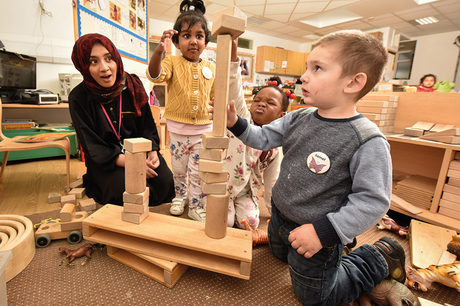
CELEBRATING CHILDREN’S LEARNING
The Celebrating Children’s Learning project is a piece of work which aims to take that argument forward. Twelve maintained nursery schools in London worked together to share examples of work on assessment in order to develop approaches which improve both quality and impact. We do not see our project as anything like the ‘final word’ in assessment. Once the project launches online in late January, there will be opportunities for other practitioners to contribute further examples of observation and assessment.
As we worked on the project, we identified four features in the most effective practice:
- you can ‘hear’ the child’s voice or ‘get a feel’ for their play
- there is keen observation of the child’s exploration, play and thinking
- the practitioner has noticed that the child is learning a new skill, or is making new links between aspects of knowledge
- there are examples of Sustained Shared Thinking, or a response from the child showing their feeling of awe and wonder.
Of course, not all good observations will show all those features. But we felt that a child’s record folder, or Learning Journey, should be rich in examples like these.
An example of good practice is the following observation of Serena, a little girl who is 18 months old. The practitioner has chosen to address this observation to the child, to make it come more alive:
I watched you today interacting with Claire [a member of staff] in the graphics area. You were watching Claire putting pencils in a cup and you picked up one with your left hand and mirrored what Claire did before. Serena, you continued doing this until most of the pencils were collected. When you saw one pencil left on the table you pointed to it with your eye gaze to Claire. She gave it to you and you took it with your left hand and put it in the cup.
A lovely example of how children encourage each other’s learning concerns two three-year-old boys playing in the puddles on a rainy day:
Clive said to Jason, ‘Jump!’ Jason jumped and landed in the puddle.
‘I do it,’ said Clive, and he had a turn but missed the puddle.
Jason said, ‘Oh no, Clive, you have to do it like this.’ He jumped again. ‘You look at the puddle and jump on it.’
Clive said, ‘OK, Jason.’ He got on the step and had another go. ‘Look at the puddle, Clive. Ready, jump!’ said Jason.
This time Clive landed in the puddle. He laughed.
In both examples, there is a kind of completeness: children take an interest in something, and they pursue their interest to a conclusion. This means that learning is captured in action: not just what the child knows, and can do, but also how they go about things, how they persevere and work with others. The following example beautifully captures the learning of Eshan, aged three, in action at Robert Owen Early Years Centre:
Eshan spent a long time cutting several pieces of string with the help of Sandra (the practitioner). Eshan counted how many pieces he had and Sandra found a box for him to keep them in. Eshan cut some more pieces of string, counting as he went. He wanted to keep cutting more and more pieces because he enjoyed cutting, sticking, and counting beyond the number he had reached. He counted all that way up to 30. Sandra then helped him to find some paper for him to stick each piece of string down.
Some of the weakest examples of practice are what I call ‘scrapbook’ entries – photos which are fun to collect together, but which do not help us understand children’s learning. Instead of that observation of Clive and Jason learning and talking together, it would be quite common just to see a photo captioned ‘Clive loves jumping in puddles!’.
We found that another style we commonly used is what I call the ‘evidence’ approach. The practitioner is so keen to capture evidence of what a child knows or can do that their time is taken up with writing down the observation or taking the photo rather than interacting with the child.
In the case of Eshan, this might mean ‘evidence’ of him counting to five would have been captured. But the opportunities to extend his activity by cutting more pieces of string, finding a place to keep them, and counting to 30, would have been missed.
A final category of poorer quality observations consists of merely rewording bullet points from Development Matters. For example, a practitioner might write, ‘Eshan uses some numbers accurately in his play.’ This offers little insight into his learning.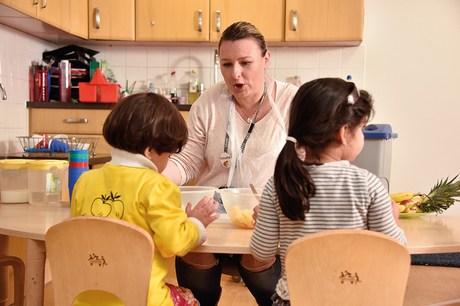
INDIVIDUAL KNOWLEDGE
Effective practice focuses on capturing the individuality of each child as a learner. We need that individual knowledge if we are going to ‘scaffold’ children’s learning – develop their interests and their ways of thinking, rather than just trying to offer them a ‘programme’ based on Development Matters. The Effective Pre-school, Primary and Secondary Education (EPPSE) project found quite clearly that this sort of response to the child, building up into episodes of Sustained Shared Thinking, was highly effective.
On the other hand, many children are switched off learning at an early age if adults merely offer them a programmatic style of teaching, drilling them in counting from one to ten without any exploration of their interests in number, or opportunities to apply their interests to real-world situations and problems.
A child has never learnt anything just because someone ‘tracked’ them or collected ‘evidence’ of their learning. Likewise, when we simply throw children back on their resources, we leave them exactly as we found them.
The child who comes up to a practitioner with a piece of the jigsaw puzzle that they cannot fit, and who is sent away to ‘try again’, has not been helped in any way. They will be unable to further their learning or develop the skill they need. On the other hand, the practitioner who ‘scaffolds’ the child’s learning – maybe by drawing their attention to the different shapes, or showing them part of the solution so they can complete the rest of the puzzle – helps the child to become a more powerful learner.
We want Celebrating Children’s Learning to keep developing with the involvement of more practitioners, until we have collated high-quality examples that show learning in every aspect of the EYFS. We hope these materials will help practitioners and settings to work together to moderate assessment judgements, just like the Exemplification Materials for the EYFS Profile.
In turn, transition from one setting to another will be smoother if practitioners are more confident to consider prior assessment information. If observations and assessments feel more lively and personal to the individual, then parents will also feel more engaged, and this will support them in becoming strong partners in the process. Ultimately, we would like to see a reduction in the quantity and complexity of assessment data in the early years, and more assessment that helps children to become better learners.
Celebrating Children’s Learning will be available online by the end of January at www.eleysp.co.uk/celebrating-childrens-learning/
Dr Julian Grenier is head teacher at Sheringham Nursery School and Children’s Centre and is a National Leader of Education.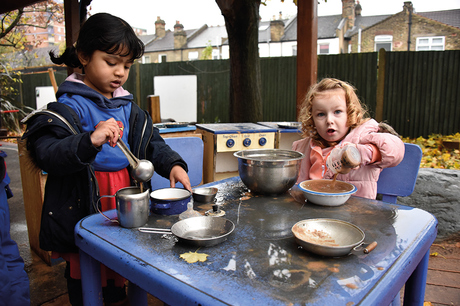
CELEBRATING CHILDREN’S LEARNING HAS BEEN DEVELOPED BY:
Claire Barber and Gill Crowley, Abbey Wood Nursery School, Greenwich
Sandra Campbell, Church Hill Nursery School, Waltham Forest
Adam Lane, Clyde Nursery School and South Thames Early Education Partnership, Greenwich
Jo Aylett, Edith Kerrison Nursery School, Newham
Kelly Hall, Kaizen Primary School, Newham
Sarah Porter, Kay Rowe Nursery School, Newham
Stella Wybron, Oliver Thomas Nursery School, Newham
Teresa Lane, Rachel McMillan Nursery School, Greenwich
Sarah Davies, Robert Owen Nursery School, Greenwich
Karla Davis, Ronald Openshaw Nursery Education Centre, Newham
Julian Grenier and Lesley Webb, Sheringham Nursery School, Newham
Linda Mullis, governor, Sheringham Nursery School, Newham
Peter Catling and Jenny Baker, Woodlands Park Nursery School, Haringey
Nicola Blatchly-Lewis, strategic manager, Learning and Achievement, Newham
Helen Moylett, early years consultant
Nancy Stewart, early years consultant
Sue Finch, early years consultant
REFERENCES
Susan Isaacs (1937) Social Development in Young Children: A study of beginnings. Routledge
Mary Jane Drummondet al(2004) Learning Without Limits. Open University Press
Alison Peacocket al (2016) Assessment for Learning Without Limits. Open University Press
The Effective Pre-school, Primary and Secondary Education (EPPSE) project, www.ucl.ac.uk/impact/case-study-repository/eppse
